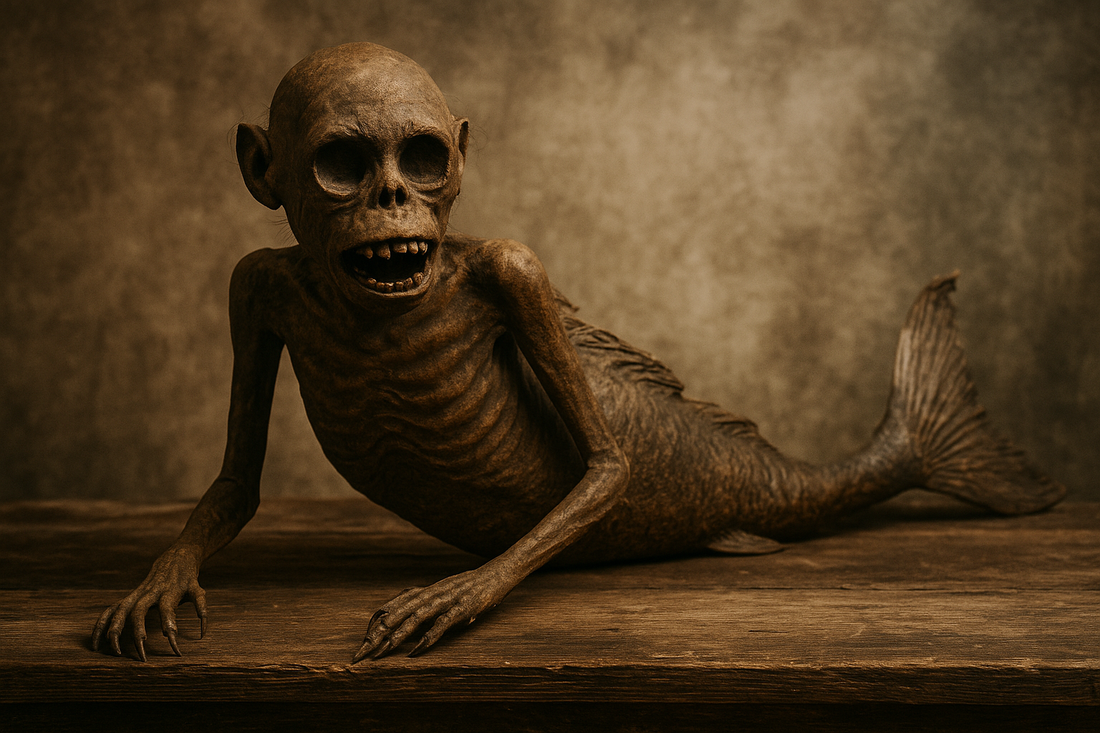
The Fiji Mermaid
Share
The Fiji Mermaid: Barnum’s Greatest Hoax
In the 1840s, Americans lined up to see a mermaid. What they got instead was a shriveled monkey stitched to half a fish — and they loved it.
Origins: From Japan to America
The so-called Feejee Mermaid wasn’t born in an ocean but in a workshop. Japanese and Southeast Asian artisans had a long tradition of crafting grotesque “mermaids” by stitching together monkey torsos and fish tails. These objects were displayed in temples as curiosities, somewhere between religious relics and carnival trickery.

One of these specimens was purchased by Captain Samuel Barrett Edes, who brought it to London in the 1820s. From there it passed through collectors’ hands until reaching Moses Kimball of the Boston Museum. Kimball lent it to his friend P.T. Barnum in 1842 — and Barnum knew exactly how to turn a taxidermy prank into a cultural sensation.
Barnum’s Salesmanship
Barnum didn’t just display the mermaid; he built an entire mythology around it. He planted fake news articles, circulated pamphlets, and commissioned a naturalist “lecture” to lend credibility. His genius wasn’t in creating the object, but in creating the buzz.
Barnum later admitted the real challenge was not whether people believed, but whether they were intrigued enough to pay:
“How to modify general incredulity in the existence of mermaids, so far as to awaken curiosity to see and examine the specimen, was now the all-important question.”
— P.T. Barnum, Struggles and Triumphs
What They Actually Saw
Visitors expecting a beautiful siren of the sea instead found something disturbing: a three-foot figure, leathery and blackened, with a gaunt monkey torso, sharp bared teeth, and sagging breasts stitched onto a scaly tail.
As The New Yorker put it:
“In the 1840s, he met a mermaid. She was just under three feet tall, with leathery skin, sharp teeth, and pendulous breasts... it had been stitched together out of parts of an orangutan, a baboon, and some kind of salmon—but that was a minor matter.”
The grotesque look was precisely what made it compelling. Audiences couldn’t decide if they were seeing fraud, oddity, or something truly unknown.
Myth, Belief, and Entertainment
The Feejee Mermaid fed into centuries of sailor tales about half-human creatures glimpsed in rough seas. By the 19th century, most naturalists dismissed such stories, but the public remained enchanted by the idea. Barnum understood that he didn’t need belief — just curiosity.
Science may have dismissed the exhibit quickly, but the press coverage and crowds kept rolling in. Spectacle always outsold truth.
The Legacy
The original Fiji Mermaid’s fate is murky. Some believe it was destroyed in a fire at Barnum’s American Museum in 1865. Others argue that fragments may still exist in private collections or museum archives. Replicas and knock-offs continued to circulate well into the 20th century — and you can still see versions today at Ripley’s Believe It or Not.
More importantly, the Feejee Mermaid became a cultural archetype: shorthand for any gaffed creature or sideshow hoax.
Pop Culture Echoes
From cryptozoology TV shows to carnival attractions, the Fiji Mermaid remains a touchstone for our fascination with the bizarre. It has appeared in novels, museum exhibits, and even in discussions of fake news — a 19th-century warning about how easily hype can overwhelm fact.
Conclusion
The Fiji Mermaid never proved mermaids were real. What it proved was far more timeless: humans will always pay to be fooled. Barnum’s stitched-up monster wasn’t just a sideshow act — it was a mirror, reflecting our need to believe in wonders, even when the seams are showing.


